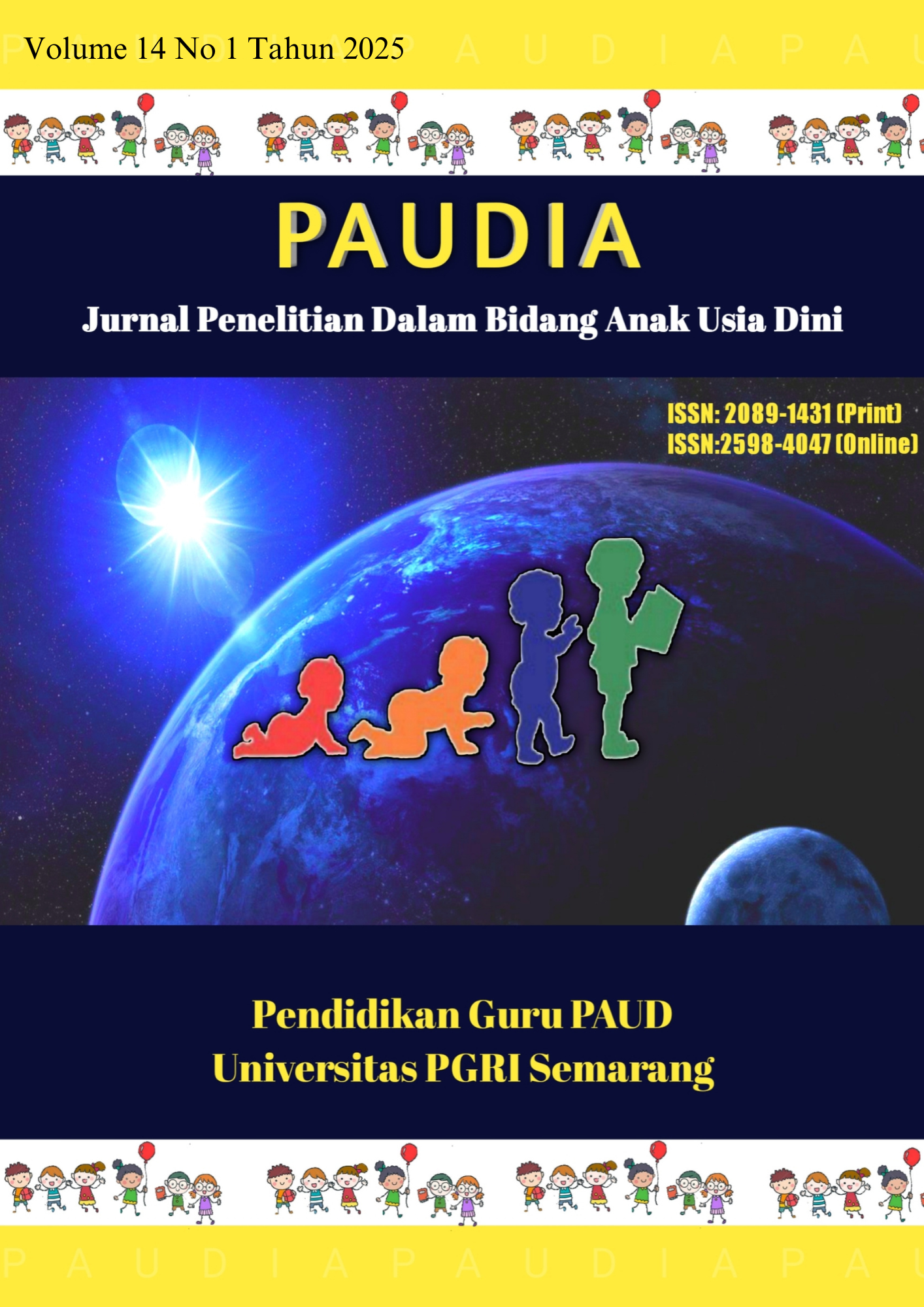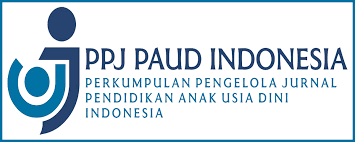Early Childhood Science Literacy Through Project Learning Using Loose Parts
DOI:
https://doi.org/10.26877/paudia.v14i1.1156Keywords:
Science Literacy, Project Learning, Loose PartsAbstract
Science literacy in early childhood is essential for building scientific understanding and skills that will continue throughout life. This article discusses the use of project learning utilizing loose part media as an effective method to improve children's science literacy. Loose parts, which include a variety of natural and artificial materials that are flexible in their use, provide opportunities for children to be creative and explore science concepts directly. This study uses the Action Research method, this study involves teachers directly in improving classroom learning practices. This study was conducted at TK Aisyiyah Bustanul Athfal 27 Depok. Data collection techniques were carried out through triangulation (interviews, observation and documentation). The technique used is purposive sampling through project learning, children are involved in the process of identifying problems, planning, data collection, analysis, and presentation of results. This approach encourages critical thinking skills, collaboration, and increases curiosity and creativity. The resulting data is processed using the Miles & Huberman Interactive Model. The results of the implementation of this method show an increase in children's understanding of science concepts and practical skills. Thus, loose parts-based project learning has proven to be an effective means to support science literacy in early childhood.
References
Adbo, K., & Carulla, C. V. (2020). Learning about science in preschool: play-based activities to support children's understanding of chemistry concepts. International Journal of Early Childhood, 52(1), 17-35. International Journal of Early Childhood (2020) 52:17–35.doi : https://doi.org/10.1007/s13158-020-00259-3
Atika, A. R., Westhisi, S. M., & Zahro, I. F. (2019). Pelatihan Literasi Sains untuk Meningkatkan Kemampuan Berpikir Ilmiah pada Guru Pendidikan Anak Usia Dini. Jurnal Pendidikan Anak Usia Dini Undiksha, 7(3), 266-271
Bell, S., Boulanger, D., & Schreiber, J. (2010). Project-Based Learning in the 21st Century: Skills for the Future. International Journal of Technology and Design Education, 20(2), 233-241.
Bybee, R., McCrae, B., & Laurie, R. (2009). PISA 2006: An assessment of scientific literacy. Journal of Research in Science Teaching: The Official Journal of the National Association for Research in Science Teaching, 46(8), 865-883. https://onlinelibrary.wiley.com/doi/abs/10.1 002/tea.20333
Blumenfeld, P. C., Kempler, T., & Krajcik, J. (1991). Motivating Project-Based Learning: Sustaining the Doing, Supporting the Learning. Educational Psychologist, 26(3-4), 369-372
Chou, et all (2022). Chinese preschool children‘s physical fitness, motor competence, executive functioning, and receptive language, math, and science performance in Kindergarten. Children and Youth Services Review. Volume 136, 106397
Demircan,H. (2022). How am I supposed to do this on my own?‖: A case study on perspectives of preschool teachers regarding integrative STEM practices. journals.sagepub.com/home/sgo. SAGE Open July-September 2020: 1–15 © The Author(s). DOI: 10.1177/2158244020938702
Dewey, J. (1938). Experience and Education. New York: Macmillan.
Fleer, M. (2011). The role of play in the development of scientific understanding. Research in Science Education, 41(1), 1-20.
Gerde,et all.(2017). Early Childhood Educators‘ Self-Efficacy in Science, Math, and Literacy Instruction and Science Practice in the Classroom. Early Education and Development. http://www.tandfonline.com/loi/heed20.Doi :http://dx.doi.org/10.1080/10409289.2017.1360127
Gropen, et al.(2017). Foundations of Science Literacy: Efficacy of a Preschool Professional Development Program in Science on Classroom Instruction, Teachers‘ Pedagogical Content Knowledge, and Children‘s Observations and Predictions. Early Education and Development ISSN: 1040-9289 (Print) 1556- 6935 (Online). From http://www.tandfonline.com/loi/heed20. http://dx.doi.org/10.1080/10409289.2017.1279527
Handayani, Peny Husna;, & Srinahyanti. (2018). Literasi Sains Ramah Anak Usia Dini. Early Childhood Education Journal of Indonesia, 1(2), 46-51. https://journal.unnes.ac.id/sju/index.php/eceji/article/view/32411
Hoh, C. (2022). Loose Parts Play: Enhancing Social Connections and Scientific Inquiry in Early Childhood. Journal of Early Childhood Research, 20(3), 234-247
Husnul Fuadi,et al.(2020). Analisis Faktor Penyebab Rendahnya Kemampuan Literasi Sains Peserta Didik. Jurnal Ilmiah profesi Pendidikan, Volume 5, Nomor 2, ISSN: 2505-7069/ 2620-8326. DOI: https://doi.org/10.29303/jipp.v5i2.122
Jones, E., & Nimmo, J. (2016). The Importance of Play in Early Childhood Science Learning. New York: Teachers College Press.
Klotz, L. (2013). Loose Parts: Inspiring Play in Young Children. Young Children, 68(4), 12-18.
McLain, J. (2020). Building Science Skills Through Loose Parts Play. International Journal of Early Childhood, 52(2), 227-243.
National Research Council. (2012). A Framework for K-12 Science Education: Practices, Crosscutting Concepts, and Core Ideas. Washington, DC: The National Academies Press.
Nugraha, A. (2008). Pengembangan Sains Pada Anak Usia Dini. Bandung: Jilsi Foundation Pembelajaran.
Pantiwati, Y. (2015). Pemanfaatan Lingkungan Sekolah sebagai Sumber Belajar dalam Lesson Study untuk Meningkatkan Metakognitif. Jurnal Bioedukatika, 3(1), 27. https://doi.org/10.26555/bioedukatika.v3i1.4144
Punia Turiman, et al (2012). Fostering the 21st Century Skills through Scientific Literacy and Science Process Skills. Faculty of Education, Universiti Kebangsaan Malaysia, 110-116.
Putri,Sugito.(2022). Pola Pembelajaran Science di Prasekolah.Jurnal obsesi. DOI: 10.31004/obsesi.v6i2.1571.Volume 6 Issue 2 (2022) . Hal. 1020-1034
Thomas, J. W. (2000). A Review of Research on Project-Based Learning. The Autodesk Foundation.
Vygotsky, L. S. (1978). Mind in Society: The Development of Higher Psychological Processes. Cambridge, MA: Harvard University Press.
Downloads
Published
Issue
Section
License
Copyright (c) 2025 Sakina, Hapidin, Yuliani Nurani

This work is licensed under a Creative Commons Attribution-NonCommercial-ShareAlike 4.0 International License.






